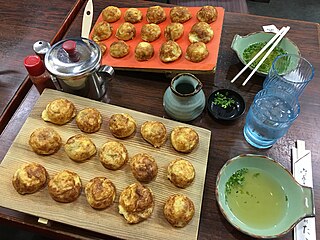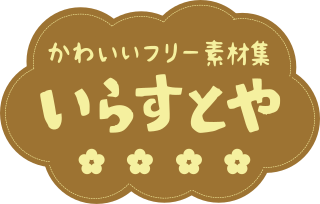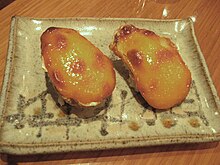
Oden is a type of nabemono consisting of several ingredients such as boiled eggs, daikon or konjac, and processed fishcakes stewed in a light, soy-flavored dashi broth.

Dango is a Japanese dumpling made from rice flour mixed with uruchi rice flour and glutinous rice flour. It is different from the method of making mochi, which is made after steaming glutinous rice. Dango is usually finished round shaped, three to five dango are often served on a skewer. Generally, dango comes under the category of wagashi, and is often served with green tea. It is eaten year-round, but the different varieties are traditionally eaten in given seasons.

Onigiri, also known as omusubi (お結び), nigirimeshi (握り飯), or rice ball, is a Japanese food made from white rice formed into triangular or cylindrical shapes and often wrapped in nori. Onigiri traditionally have sour or salty fillings such as umeboshi, salted salmon, katsuobushi, kombu, tarako or mentaiko, or takanazuke. Because it is easily portable and eaten by hand, onigiri has been used as portable food or bento from ancient times to the present day. Originally, it was used as a way to use and store left-over rice, but it later became a regular meal. Many Japanese convenience stores and supermarkets stock their onigiri with various fillings and flavors. It has become so mainstream that it is even served in izakayas and sit-down restaurants. There are even specialized shops which only sell onigiri to take out. Due to the popularity of this trend in Japan, onigiri has become a popular staple in Japanese restaurants worldwide.

Okonomiyaki is a Japanese teppanyaki, savory pancake dish consisting of wheat flour batter and other ingredients cooked on a teppan. Common additions include cabbage, meat, and seafood, and toppings include okonomiyaki sauce, aonori, katsuobushi, Japanese mayonnaise, and pickled ginger.

Akashiyaki (明石焼き) is a small round dumpling from the city of Akashi in Hyōgo Prefecture, Japan. The dumpling is made of an egg-rich batter and octopus dipped into dashi before eating. Modern style akashiyaki first started selling in the Taishō period by a yatai shopper Seitarō Mukai.

Japanese cuisine has a vast array of regional specialities known as kyōdo ryōri (郷土料理) in Japanese, many of them originating from dishes prepared using local ingredients and traditional recipes.

Tamagoyaki is a type of Japanese omelette made by rolling together several layers of fried beaten eggs. It is often prepared in a rectangular omelette pan called a makiyakinabe or tamagoyaki. The word "tamago" means egg in Japanese, and the word "yaki" means to be cooked over direct heat.

Imagawayaki (今川焼き) is a wagashi often found at Japanese festivals as well as outside Japan, in countries such as Taiwan and South Korea. It is made of batter in a special pan, and filled with sweet azuki bean paste, although it is becoming increasingly popular to use a wider variety of fillings such as vanilla custard, different fruit custards and preserves, curry, different meat and vegetable fillings, potato and mayonnaise. Imagawayaki are similar to dorayaki, but the latter are two separate pancakes sandwiched around the filling after cooking, and are often served cold.
The Braille pattern dots-1 is a 6-dot or 8-dot braille cell with the top left dot raised. It is represented by the Unicode code point U+2801, and in Braille ASCII with "A".
The Braille pattern dots-2 is a 6-dot braille cell with the middle-left dot raised, or an 8-dot braille cell with its mid-high left dot raised. It is represented by the Unicode code point U+2802, and in Braille ASCII with the number "1".
The Braille pattern dots-4 is a 6-dot or 8-dot braille cell with the top right dot raised. It is represented by the Unicode code point U+2808, and in Braille ASCII with the "at" sign: @.
The Braille pattern dots-34 is a 6-dot braille cell with the top right and bottom left dots raised, or an 8-dot braille cell with the top right and lower-middle dots raised. It is represented by the Unicode code point U+280c, and in Braille ASCII with the slash: /.
The Braille pattern dots-25 is a 6-dot braille cell with both middle dots raised, or an 8-dot braille cell with both upper-middle dots raised. It is represented by the Unicode code point U+2812, and in Braille ASCII with the number 3.
The Braille pattern dots-12346 is a 6-dot braille cell with both top, both bottom, and the middle left dots raised, or an 8-dot braille cell with both top, both lower-middle, and the upper-middle left dots raised. It is represented by the Unicode code point U+282f, and in Braille ASCII with the ampersand: &.
The Braille pattern dots-256 is a 6-dot braille cell with both middle, and the bottom right dots raised, or an 8-dot braille cell with both upper-middle, and the lower-middle right dots raised. It is represented by the Unicode code point U+2832, and in Braille ASCII with the number 4.
The Braille pattern dots-1456 is a 6-dot braille cell with both top, the middle right, and bottom right dots raised, or an 8-dot braille cell with both top, the upper-middle right, and lower-middle right dots raised. It is represented by the Unicode code point U+2839, and in Braille ASCII with a question mark: ?.
The Braille pattern dots-3456 is a 6-dot braille cell with the top right, middle right, and both bottom dots raised, or an 8-dot braille cell with the top right, upper-middle right, and both lower-middle dots raised. It is represented by the Unicode code point U+283c, and in Braille ASCII with a number sign: #.
The Braille pattern dots-23456 is a 6-dot braille cell with the top right, both middle, and both bottom dots raised, or an 8-dot braille cell with the top right, both upper-middle, and both lower-middle dots raised. It is represented by the Unicode code point U+283e, and in Braille ASCII with a close parenthesis: ).

Irasutoya is a website operated by illustrator Takashi Mifune that offers gratis clip art illustrations. These works can be used for both commercial and non-commercial applications, but copyright is not waived, there are moral rights-related restrictions on how they should be used, and restrictions to use amount per commercial project.









